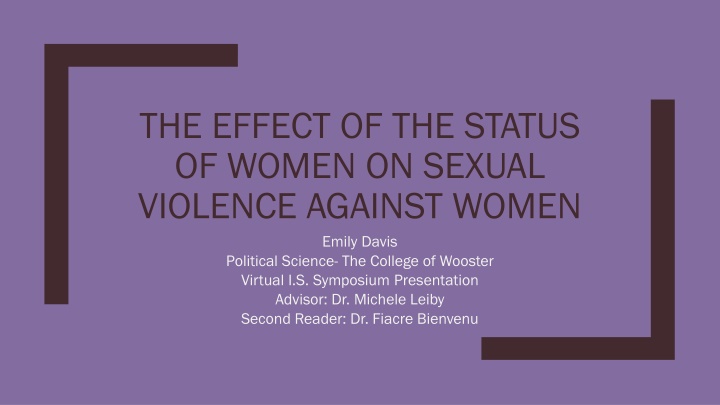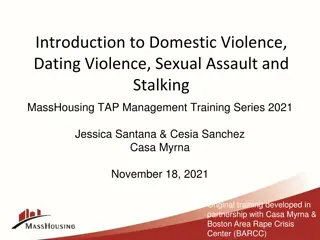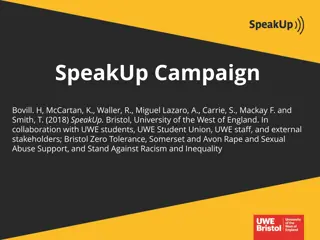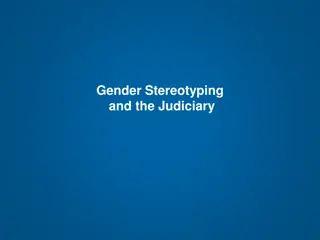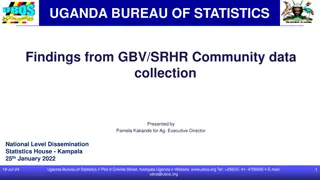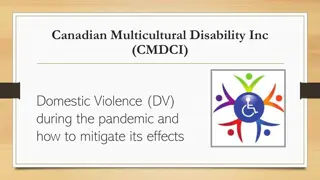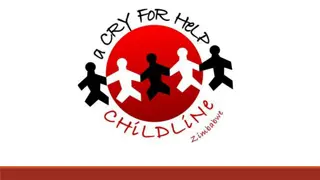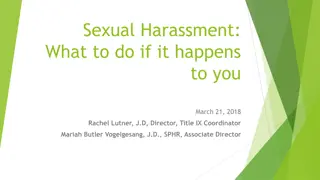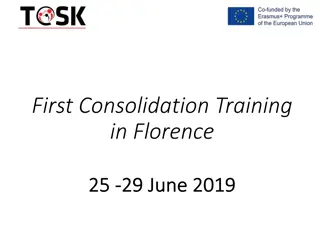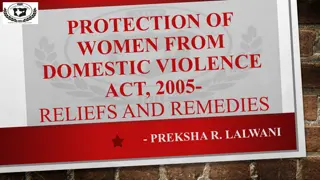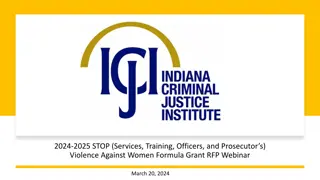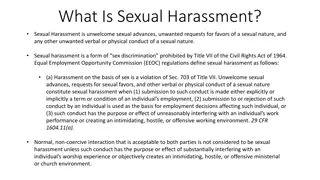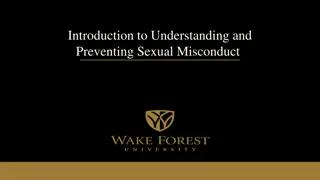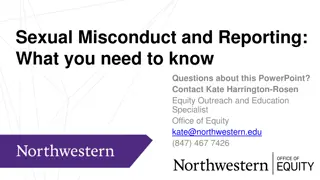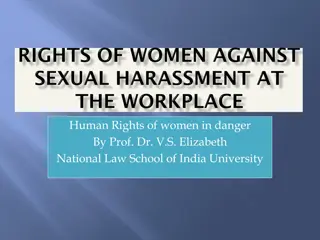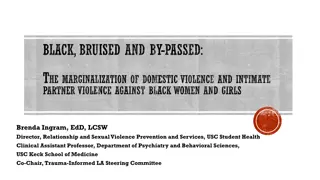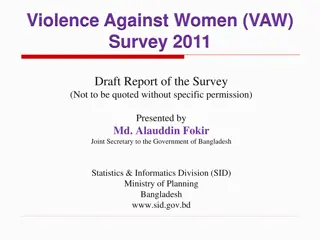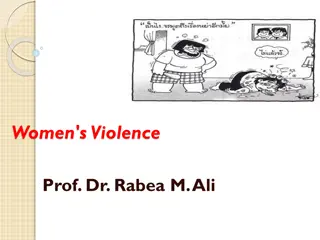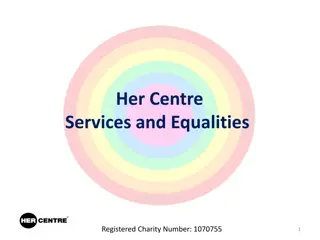Effect of Women's Status on Sexual Violence: Backlash Study
This study analyzes the impact of women's status on sexual violence, focusing on the presence of backlash and societal attitudes. Through a longitudinal case study in South Africa, the research examines the relationship between women's rights progression and instances of sexual violence post-conflict. Explore the influence of legal, political, economic rights, and social norms on gender-based violence.
Download Presentation

Please find below an Image/Link to download the presentation.
The content on the website is provided AS IS for your information and personal use only. It may not be sold, licensed, or shared on other websites without obtaining consent from the author.If you encounter any issues during the download, it is possible that the publisher has removed the file from their server.
You are allowed to download the files provided on this website for personal or commercial use, subject to the condition that they are used lawfully. All files are the property of their respective owners.
The content on the website is provided AS IS for your information and personal use only. It may not be sold, licensed, or shared on other websites without obtaining consent from the author.
E N D
Presentation Transcript
THE EFFECT OF THE STATUS OF WOMEN ON SEXUAL VIOLENCE AGAINST WOMEN Emily Davis Political Science- The College of Wooster Virtual I.S. Symposium Presentation Advisor: Dr. Michele Leiby Second Reader: Dr. Fiacre Bienvenu
Outline General Topic..........................................................................................................Slide 3 Literature Review....................................................................................................Slide 4 Theory......................................................................................................................Slide 5 Research Methods & Design.................................................................................Slide 6 Case Study...............................................................................................................Slide 7 Analysis....................................................................................................................Slide 8 Conclusion...............................................................................................................Slide 9 References............................................................................................................Slide 10
General Topic This study seeks to understand the relationship between the status of women, the presence of sexual violence, and the backlash effect. Specifically, this study questions whether societal backlash occurs in the form of increased sexual violence as a result of an improvement in the status of women. I hypothesize that the status of women influences the presence of sexual violence conditional on time in which women have gained rights or pushed for more rights. I use a longitudinal case study approach to analyze the relationship between the status of women and sexual violence during and after conflict in South Africa. This Independent Study finds probable linkage between the status of women and sexual violence because of the backlash from society.
Literature Review The Status of Women Legal & Political Rights The foundation that determines if they have access to basic human rights. Reclusive: Laws restricting movement, laws not being enforced, rates of investigation, lack of reproductive rights, women not knowing their rights, rape and martial rape not being considered a crime, lack of commitment to international agreements, etc. Progressive: Laws against sexual violence that is not gender specific, reproductive rights, international agreements are implemented and followed, etc. Social Norms Social norms are rules and standards that are understood by members of a group, and that guide and/or constrain social behavior without the force of laws. (Sherif, 152). Reclusive: Not being allowed to talk about rape, community shuns victims of sexual violence, rape a part of wartime culture, gender in war impacting identity, etc. Progressive: Right to go to school, shared experiences increase gender identity, rape not being gender specific, etc. Economic Rights Right to work and economic independence. Reclusive: Sexual violence is cheap, prostitution and human trafficking source of income, sex segregation of jobs, discrimination by employers, gender wage gap, gender socialization, women only seen as reproducers, etc. Progressive: Increase in employment outside the home, etc. The Backlash Effect An adverse response from those who believe women do not have right to certain values.
Theory __ Research Question: What is the variable role of the status of women on the perpetration of sexual violence in conflict and post-conflict settings? Status of Women (IV) Sexual Violence (DV) Transitional Phase (Conditional Variable) Hypothesis: When there is an increase in women s rights or a push for women s rights, there will be a momentary resurgence in sexual violence.
Research Methods & Design Research Design Longitudinal case study Look at the status of women and sexual violence over an extended period. Case Selection Why South Africa? Information available before and after apartheid. Post Cold War. Variation in levels of sexual violence over time. Concepts & Variables Dependent Variable: Sexual Violence any form of sexual penetration, such as but not limited to, sexual slavery, forced prostitution, forced pregnancy, sexual mutilation, and sexual torture in any setting. Independent Variable: The Status of Women women s social, political, professional, or other stature in society. Conditional Variable: Time the time immediately following a measurable increase in either the gaining of women s rights or the demand for women s rights.
Case Study: South Africa During apartheid Post- apartheid Sexual Violence Physical and mental humiliation. Large statistical evidence of domestic violence. Lack of reporting of sexual violence and arresting of sexual violence perpetrators. Status of Women Black South African women doubly disadvantaged. Myths and social stigma of victims of sexual violence- intensified by HIV/AID myths. Social norms disturbed. Rights were not being met. Lack of equal pay or employment. Sexual Violence Sexual violence still present, but highly unreported. Lack of police trust. Education and Economic status plays a role in its presence. Status of Women Some political & legal improvements. Increase myths and social stigma of victims of sexual violence- intensified by HIV/AIDS myths. Legal issues regarding trying those who perpetrate sexual violence.
Analysis Post-apartheid, laws were put in place to protect women, but sexual violence and violence against women still occur. Black South African women faced backlash in two ways; through their gender and through their race. The relationship between the status of women and sexual violence The relationship between the status of women and sexual violence suggests that the status of women may correlate with the suggests that the status of women may correlate with the presence and prevalence of sexual violence. presence and prevalence of sexual violence. The backlash effect also may play a role is this phenomenon. The backlash effect also may play a role is this phenomenon.
Strengths & Weaknesses I am only scratching the surface of this topic. Sometimes hard to connect personal stories with statistical evidence. Lack of information in general. What I Learned I.S. is really hard! I did not fully answer my research question because of limited time and information. I came out of I.S. with more questions than answers. CONCLUSION
References Africa :: South Africa The World Factbook - Central Intelligence Agency. https://www.cia.gov/library/publications/the-world-factbook/geos/sf.html (December 30, 2019). APARTHEID | Definition in the Cambridge English Dictionary. https://dictionary.cambridge.org/us/dictionary/english/apartheid (February 1, 2020). Forced Removals in South Africa | South African History Online. https://www.sahistory.org.za/article/forced-removals-south-africa (February 22, 2020). South Africa Profile- BBC. 2018. BBC News. https://www.bbc.com/news/world-africa-14094918 (January 31, 2020). The South African General Elections: 1994 | South African History Online. https://www.sahistory.org.za/article/south-african-general-elections-1994 (February 22, 2020). UCDP - Uppsala Conflict Data Program. https://ucdp.uu.se/ (December 4, 2019). UMkhonto WeSizwe (MK) | South African History Online. https://www.sahistory.org.za/article/umkhonto-wesizwe-mk (February 9, 2020). Abrahams, Naeemah et al. 2017. Sexual Homicides in South Africa: A National Cross-Sectional Epidemiological Study of Adult Women and Children ed. Soraya Seedat. PLOS ONE 12(10): e0186432. Avdeyeva, Olga. 2007. When Do States Comply with International Treaties? Policies on Violence against Women in Post-Communist Countries. International Studies Quarterly51(4): 877 900. doi: 10.1111/j.1468-2478.2007.00481.x. Benard, Cheryl, Seth G. Jones, Olga Oliker, and Cathryn Quantic Thurston. 2008. The Security Dimension and Women. In Women and Nation-Building, RAND Corporation, 15 35. Brownmiller, Susan. 1975. Against Our Will; Men, Women, and Rape. New York, NY: Simon and Schuster. Campbell, Patricia J. 2000. The Truth and Reconciliation Commission (TRC): Human Rights and State Transitions--The South Africa Model. 4(3): 23. Cohen, Dara Kay, and Ragnhild Nord s. 2019. Sexual Violence in Armed Conflict Data Project (SVAC) 2.0, 1989-2015 Codebook and Instruction Manual November 2019. : 17. Cohen, Dara Kay. 2013. Explaining Rape during Civil War: Cross-National Evidence (1980 2009). American Political Science Review107(3): 461 77. doi: 10.1017/s0003055413000221. Coleman, Isobel. 2004. The Payoff from Womens Rights. Foreign Affairs83(3): 80. doi: 10.2307/20033977. DeMinck, Ashley. The Origins of Truth and Reconciliation Commissions: South Africa, Sierra Leone, and Peru. : 39. England, Paula, and Irene Browne. 1992. Trends in Womens Economic Status. Sociological Perspectives35(1): 17 51. doi: 10.2307/1389367. Faludi, Susan. 2006. Backlash: the Undeclared War against American Women. New York: Three Rivers Press. Gump, James O. 2003. Civil Wars in South Dakota and South Africa: The Role of the Third Force. Western Historical Quarterly 34(4): 427 44.
References Handrahan, Lori. 2004. Conflict, Gender, Ethnicity and Post-Conflict Reconstruction. Security Dialogue35(4): 429 45. doi: 10.1177/0967010604049521. Human Rights Watch. Sexual Violence in South African Society. https://www.hrw.org/reports/2001/safrica/ZA-FINAL-03.htm. https://www.hrw.org/reports/2001/safrica/ZA-FINAL-03.htm#P475_58334 (January 20, 2020). Isikozlu, Elvan, and Ananda S. Millard. 2010. Wartime Rape: Identifying Knowledge Gaps and Their Implications. Sicherheit und Frieden (S F) / Security and Peace28(1): 35 41. https://www.jstor.org/stable/24233006. Kaufman, Stuart J. 2017. South Africa s Civil War, 1985 1995. South African Journal of International Affairs 24(4): 501 21. Kirby, Paul. 2012. How Is Rape a Weapon of War? Feminist International Relations, Modes of Critical Explanation and the Study of Wartime Sexual Violence. European Journal of International Relations19(4): 797 821. doi: 10.1177/1354066111427614. Krook, Mona Lena. 2015. Empowerment versus Backlash: Gender Quotas and Critical Mass Theory. Politics, Groups, and Identities3(1): 184 88. doi: 10.1080/21565503.2014.999806. Lipman, Beata, ed. 1984. We Make Freedom: Women in South Africa. London; Boston: Pandora Press. Misra, Joya, and Eiko Strader. 2013. GENDER PAY EQUITY IN ADVANCED COUNTRIES: THE ROLE OF PARENTHOOD AND POLICIES. Journal of International Affairs 67(1): 27 41. Oslo (PRIO), Peace Pesearch Institute. ACLED - Armed Conflict Location and Event Data - PRIO. https://www.prio.org/Data/Armed-Conflict/Armed-Conflict-Location-and-Event-Data/ (December 2, 2019). Pizzarossa, Luc a Berro, and Katrina S. Perehudoff. 2017. Mapping Constitutional Commitments on Sexual and Reproductive Health and Rights A Global Survey. Healthcare as a Human Rights Issue: 321 46. doi: 10.14361/9783839440544-012. Rudman, Laurie A., and Peter Glick. 1999. Feminized Management and Backlash toward Agentic Women: The Hidden Costs to Women of a Kinder, Gentler Image of Middle Managers. Journal of Personality and Social Psychology77(5): 1004 10. doi: 10.1037//0022-3514.77.5.1004. Sachs, Albie. 1990. Judges and Gender: The Constitutional Rights of Women in a Post-Apartheid South Africa. Agenda: Empowering Women for Gender Equity (7): 1 11. Sanford, Victoria, Katerina Stefatos, and Cecilia M. Salvi. 2016. Gender Violence in Peace and War: States of Complicity. New Brunswick: Rutgers University Press. Sherif, M. (1936). The psychology of social norms. Oxford, England: Harper. Shiela Meintjes, and Beth Goldblatt. Gender and the Truth and Reconciliation Commission. https://www.justice.gov.za/trc/hrvtrans/submit/gender.htm (February 10, 2020). Snider, Laureen. 1998. TOWARDS SAFER SOCIETIES: Punishment, Masculinities and Violence Against Women. The British Journal of Criminology 38(1): 1 39. The Republic of South Africa. 1998. South Africa Demographic and Health Survey 1998. The Republic of South Africa. 2003. South Africa Demographic and Health Survey 2003. The Republic of South Africa. 2016. South Africa Demographic and Health Survey 2016. Thorpe, Jen, ed. 2018. Feminism Is- South Africans Speak Their Truth. Kwela Books. van der Bijl, Charnelle, and Philip N. S. Rumney. 2009. Attitudes, Rape and Law Reform in South Africa. The Journal of Criminal Law 73(5): 414 29. WVS Database. (1984) http://www.worldvaluessurvey.org/WVSContents.jsp (March 5, 2020).
